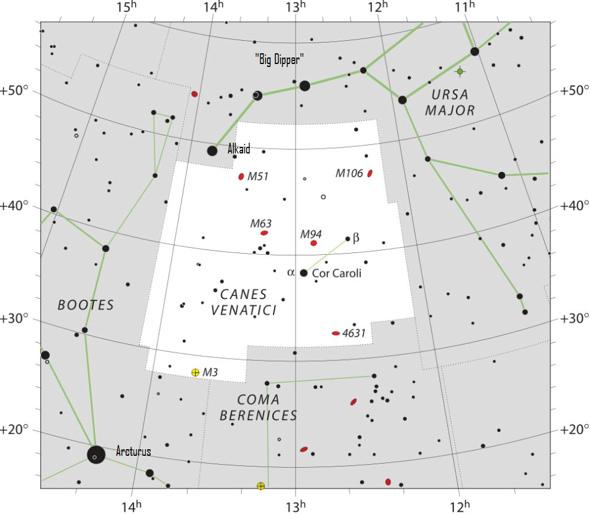Canes Venatici — The Hunting Dogs
April 24, 2024

Source: International Astronomical Union / Wikimedia Commons
Spring is an excellent time to view the Big Dipper in the northwest sky soon after sunset. While doing so, it is also a good time to identify the two largest stars within the Hunting Dogs (Canes Venatici) constellation. Cor Caroli – aka Alpha Canum Venaticorum – is the brightest star in the constellation, and Chara, Canes Venatici’s 2nd-brightest star, are probably the only two stars you’ll ever come to know within the boundaries of this constellation. Both of these stars appear together, akin to Gemini’s Twins (Castor and Pollux), snuggled under the last two stars in the Big Dipper’s handle. Here, near the crest of the Sierra Nevada and our relatively dark sky, you should be able to pick out the faint pair easily with just your eyes on a cloudless, new moon evening.
Meanwhile, if you happen to have access to a telescope with a magnifying power of at least 40, you will see Cor Caroli is actually a two-star binary system. A large telescope using even more magnification will reveal the colors of the two stars: the brighter star is white or blue-white and the fainter star (Chara) carries a mild lilac color.
The extreme south boundary of this constellation is also the home for the M3 globular star cluster, one of the most easily seen conglomerations of stars in the sky, located roughly 34,000 light years away from the earth. On the northwest boundary of Canes Venatici the famous Whirlpool Galaxy, the first celestial object seen to have a spiral structure, is located - a mere 23 million light-years away.
Featured Articles

Storms Bring Heavy Rainfall and Local Disruptions →
December 22, 2025
Sierra County faces power outages and water issues amid heavy rainfall and storm warnings.
215 Animals Seized for Cruelty from Grass Valley Property →
December 22, 2025
Human Remains Found Near South Yuba Bridge in March Identified →
December 17, 2025
Transfer Station Burn Suspended After Community Concerns →
December 16, 2025
Sierra Hardware Plans Extensive Repairs After Flood Damage →
December 8, 2025
